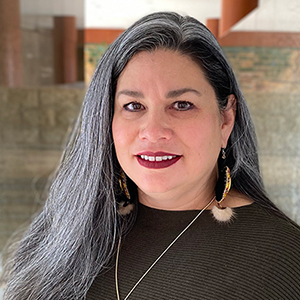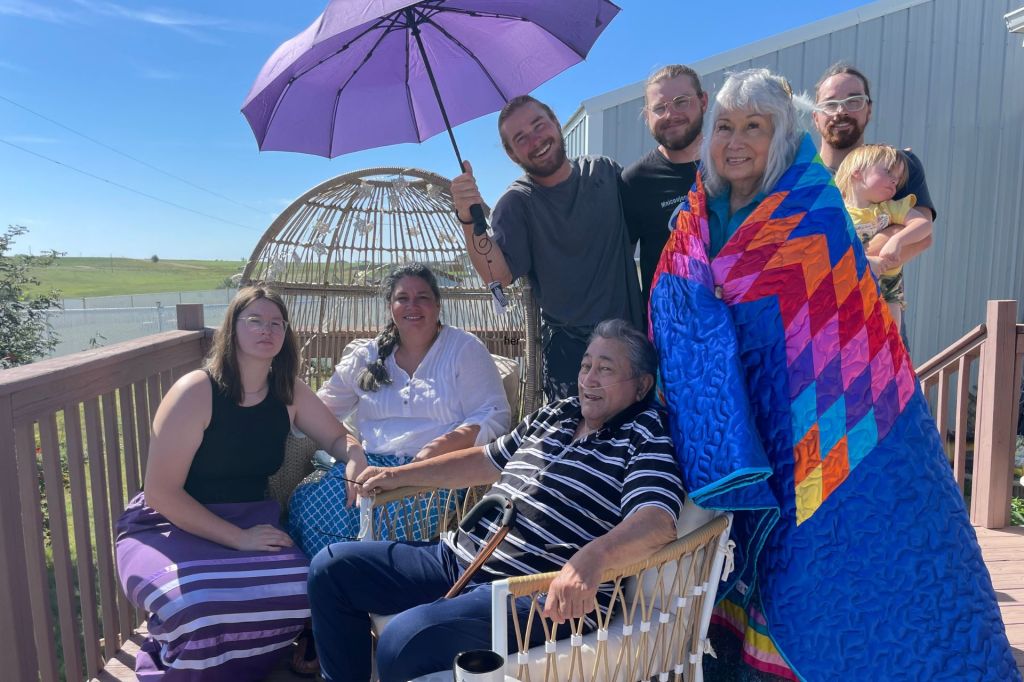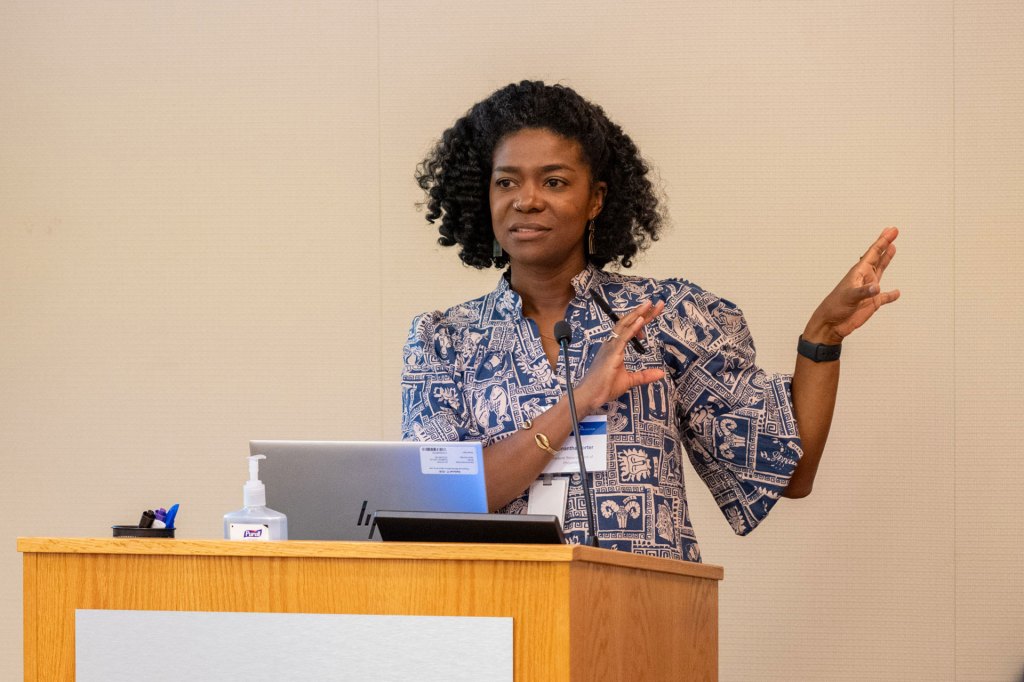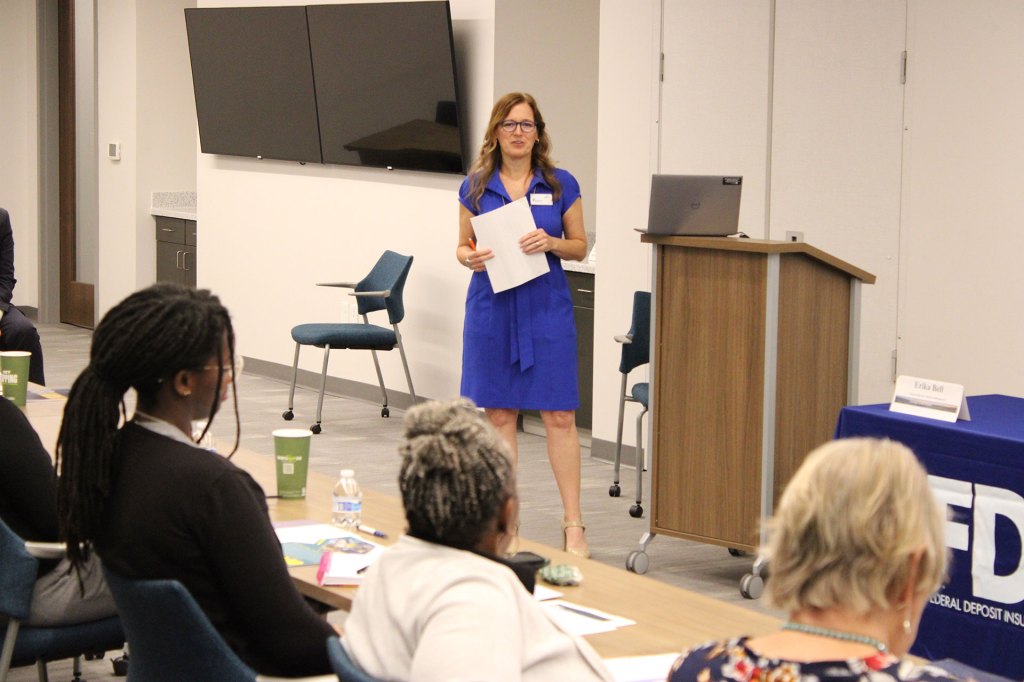Heather Sobrepena (second from left), Engagement Director, Center for Indian Country Development at the Minneapolis Fed, with her family at her mother’s naming ceremony.
Heather Sobrepena is a Cheyenne River Sioux and Crow tribal member. She’s also the engagement director for the Minneapolis Fed’s Center for Indian Country Development (CICD). She appreciates how her personal and professional connections to the Native American community and community development intersect. Heather works eagerly to make sure that Native communities are part of a growing economy and a stable financial system that works for all. She regularly and intentionally interacts with national and regional organizations, tribal nations, and Indigenous communities.
“I think that community development is a process of reclaiming our own narrative and our stories,” Heather explained. “That it’s not something out of reach for my relatives in Indian Country – to be able to support economic development and use tribal governance and sovereignty of tribal nations to chart our own economic prosperity and future.”
The CICD supports the prosperity of Native nations and Indigenous communities through data and research that makes substantial contributions to public policy. Their goal is to create an environment for action and change. One of the CICD’s tactics is to engage with Native nations and Indigenous communities, businesses, and organizations to understand their economic conditions and opportunities.
Supporting the CICD and valuing ancestry
To support the CICD’s engagement strategy, Heather coordinates national and regional efforts. She arranges meetings to introduce people to the work of the Fed. She also helps to organize events to address topics that are relevant in Indian Country and delivers presentations to national and regional organizations.
For example, the CICD held a four-part webinar series titled “Cultivating Native Economies in the 21st Century.” The series focused on opportunities in tribal broadband and lending insights, best practices, and policy considerations for Native community development financial institutions (CDFIs). The series also focused on opportunities and barriers in Native federal contracting. “I’m always trying to look from the lens of how the CICD is providing value. A big part of what I try to do is show how our work is relevant to people’s lives,” Heather said. “My role is very much about relationships, people, and community. I work to give a voice to Indian Country. It has long been missing in terms of financial and economic data, and financial inclusion.”
Heather’s Native American mother and her mother’s siblings were adopted by a non-Native American family at a young age. “When I go back home to Cheyenne River, South Dakota, where my mom is from for ceremonies or celebrations, it’s very different than our lived experience in non-Native communities in Montana.” For Heather, that perspective as a child evolved into trying to better understand why economic development programs that were intended to improve socio-economic outcomes weren’t having the same impact in Native populations as they were in others. “I began to ask what programs need to look like so that they’re effective and create change for the people they were intended to benefit.”

“I think that community development is a process of reclaiming our own narrative and our stories. It’s not something out of reach for my relatives in Indian Country – to be able to support economic development and use tribal governance and sovereignty of tribal nations to chart our own economic prosperity and future.”
Advocating for tribal communities in Montana
Prior to joining the Fed, Heather spent most of her career working for the State of Montana. During that time, she oversaw the state’s tribal economic development programs for the Department of Commerce. As the program administrator, she worked with private-sector development and discovered a lack of private-sector support for Native-owned businesses.
That recognition led her to focus on this lack of support at a policy level. She regularly convened a governor-appointed commission to focus on economic development areas that are important to tribes in Montana, such as small business development. She helped ensure that state program resources were accessible and that programs reflected the needs of Native communities. “In this role, I made a lot of deep friendships and developed a passion for making sure that Indian Country has a seat at the table,” Heather said. “So that work really has shaped why I’m so in love with the work that I’m doing for the CICD.”
Using data to help tell stories
The CICD offers many robust and rich data resources. For example, the Native American Funding and Finance Atlas helps identify economic development resources and opportunities in Indian Country. Other resources include an interactive map of Native American financial institution locations and a Native American labor market dashboard. The CICD also provides policy tools, handbooks, and how-to guides. “There’s been a data gap or a level of invisibility for Indian Country for a long time,” Heather explained. “But then to provide data tools that would be expensive for tribal governments or communities to provide on their own is even more rewarding. This data allows our relatives and communities to tell their own stories.”
Heather remains hopeful about the economic potential in Indian Country but reinforces that respecting culture and indigenous ways of knowing and being are crucial. “I think solutions to challenges are going to come from within Indian Country,” she said. “It’s important that people who aren’t familiar with Indian Country but are in positions of political authority or are decision makers take the time to get to know and develop trusting relationships with the communities they are serving. This must be done to understand the details of any problem for which they’re trying to influence policy solutions.”










